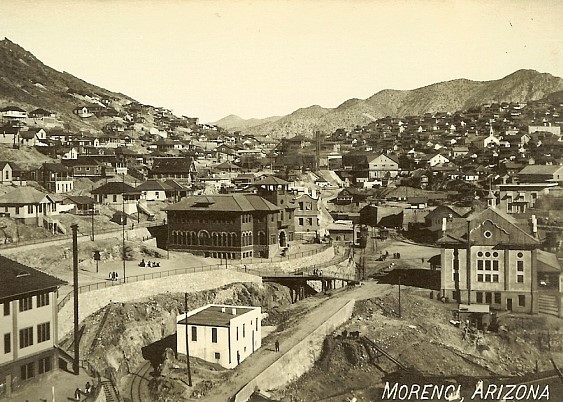
 Francesco Gallo
Francesco Gallo
IT and US: The Italy-Morenci connection. Pioneers from Italy to Morenci, AZ from 1872 to 1920
- WTI Magazine #126 Apr 18, 2020
-

 Francesco Gallo
Francesco Gallo
The book “The Italy-Morenci Connection: Pioneers from Italy to Morenci AZ” is a tribute to our brave forefathers, the vast majority of whom had no formal education or of any knowledge of the English language, who in defiance to the unknown, left their native soil to venture in a wild semi-unexplored territory hoping to find a better life for themselves and for their families.
It describes how they contributed to make the Morenci the largest copper mining operation in North America and one of the largest copper mines in the world. It recalls that from 1872 to 1920, 371 emigrants arrived from Italy to Morenci, Clifton and Metcalf (Arizona) USA when the average population of each town was 3150 people.
It is estimated that over 2000 descendants of these pioneers are now living in various cities of Arizona (Scottsdale, Prescott, Tucson, Phoenix, Bisbee, Safford, Paradise Valley, Yuma), California (Los Angeles, San Francisco, Huntington Beach), New Mexico and Texas (El Paso). There are only 79 descendants in Morenci and Clifton since 1930, they started moving out of the Morenci area.
Contrary to what had occurred in large cities of the Northeast, settling in Morenci was a one-way permanent decision without any plan to return to their hometowns. Thus, upon arrival, many tried to adapt to the environment, yet preserved certain Italian traditions, for instance, create a strong united family, work hard to better themselves socially and economically, and attend liturgical services at Holy Cross Parish of Morenci or the Sacred Heart Parish of Clifton, places where all the common countrymen met on Sundays.
From 1880 until 1915, 4 millons Italians emigrated to USA, 70% from the South and 30% from the North, mostly from Piedmont, Veneto and Friuli. Early Piedmontese emigration (1865 to 1880) was due to poverty and unemployment especially when the capital of Italy was moved from Turin to Florence and then to Rome and thus, state employees lost their jobs and decided to emigrate.
Economic problems were not the only reasons that led them to emigrate. For instance, in July 1884, cholera spread from Switzerland to Piedmont, Lombardy and Liguria. In September 1884, cholera also hit Calabria, Campania and Sicily. In 1908 the earthquake of Messina caused 100,000 deaths with destruction of their homes. Post war disasters from World War I also forced many to leave Italy.
Upon disembarking from the ship, they entered a sort of culture shock, everything looked strange and they felt really distant from the people around them. Slowly, they understood the importance of finding a job, learning English and getting accustomed to the new environment. Luckily, being a copper miner did not require much speaking English and they found work feasible as they were used to hard work, 12 hours a day, six days a week.
The first Italians who began coming to Morenci in 1872, traveled on wagon trains which were often raided by Indians. As they arrived, they were happy to discover that the “Founder of the State of Arizona” had been an Italian missionary priest named Father Eusebio Francesco Chini AKA “Kino” (1645-1711) who was born in Segno (Trento) and who had founded 24 missions in Arizona and Mexico in the XVII century. This fact gave them a sense of respect and pride for their national heritage. These pioneers, courageously settled in a lawless wilderness they tried to ameliorate.
Once they reached Morenci, they were nervous, excited, and frightened at the same time and had no idea what type of life would await them. They found Morenci to be different than most towns with public municipal administrative offices and services. It was a company town without a Mayor. Stores and housing were owned by the copper mine company who was also their employer. It owned school and church buildings, farms, parks, markets, banks, saloons, hospitals and recreation facilities and provided services to miners. It was economically united to Clifton and Metcalf, two neighboring towns which were only six miles apart.
No one paid taxes either to town or county. There was no electric light bills to pay. Wood and water were free for the taking, and so was the game. Thus the people were freed from all the worries of civilized life.
Employees benefited from the stepping stones the company provided. For many, it was a way to come to America, gain experience, save money, and buy a house. The benefits of these towns also encouraged a community atmosphere absent in many others simply because they all worked and lived together in close proximity and in isolation.
In its early days, its citizens worked as miners, as craftsmen, as copper smelters and extractors or as public health personnel (Morenci Hospital), jail guards (Clifton Jail) and cemetery attendants (Bunkers, Old Mexican and Old Morenci Cemeteries, Sacred Heart Cemetery in Clifton and Metcalf Cemetery), water supply servicemen, farmers, railroad and road workers, school teachers or janitors (grammar and high schools in Morenci, Clifton and Metcalf), store keepers, clerks in banks, shipping services and legal offices, lumber suppliers, trade shop attendants, saloon keepers and hotel clerks (Morenci Hotel). Among their workers were also carpenters, pipe fitters, boiler makers, pipe fitters, timbermen, welders, trainmen and hoist engineers. The owners aimed to make employees dependent on them, wished to improve their morals, discourage drunkenness, gambling and bad language.
Westward expansion demanded use of railroads, steel mills and lumber mills all over the country. Trains needed coal to run, new towns and cities required wood for erecting buildings, and copper was needed in construction, electrical wires, machinery, tools, alloys of gold and silver, coins and kitchen utensils.
Starting with 1872, Italian immigrants began settling in the area, helping to build the town and contributing to improve it socially and culturally as can be testified by the success obtained by certain immigrants or by their children.
John F. Vozza, the son of a Laghitan immigrant, became a Professor of Chemistry at the University of Wisconsin.
David C. Naccarati (b.1953) grandchild of Carmine Naccarato (1893-1952) born in Terrati CS, became the President of the Phelps-Dodge Company.
Charles Quarello (1905-1983) son of Tommaso Quarello (1875-1958) born in Forno Rivara TO, became the Mayor of Walkelman AZ.
Francesco Palumbo (1874-1921) from Lago CS, was a union leader during the 1905-miners strike in Morenci.
Giovan Battista Gabusi (1872-1954) born in Milano, became a distinguished photographer in Clifton in 1940 and his grandchild Frank Gabusi Jr. (1941-2005) became a Senior Executive in the Jimmy Carter Administration and later Vice Chancellor at Pima Community College.
Salvador Domenico De Grazia (1881-1940), a Laghitan who became a mine foreman at Phelps Dodge Copper Mine Company, had a son Ettorino AKA “Ted” De Grazia (1909-1982) who after he obtained three college degrees, became a world-famous impressionist artist, painter, sculptor, composer, actor, director, designer, architect, jeweler and lithographer.
Guido Cislaghi (1906-1981) son of Daniel Paul Cislaghi (1870-1929) from Cuggiòno MI, became the Superintendent of the Clifton Public School District No. 3.
Ferdinando Chiappetta (1898-1964) was a Laghitan miner whose son Donald Louis (b.1933) and grandson Donald Craig (b.1958) became dentists in Scottsdale AZ.
Ippolito Coscarella (1855-1942), a resident of Lago married to a Laghitan, became one of the richest citizens of Clifton AZ since he owned the “Cascarelli Building”, the largest ranch in the York Valley, Lyric Theater, three houses and a saloon.
Paul Carabelli (b.1876) born in Induno VA, was a mining engineer in Morenci.
The demographics of Morenci show that its population was at its peak in 1920 with 7,501 inhabitants dropping to 5,108 in 1930 and to 2,431 in 1960.
The population of Clifton followed a similar pattern with its 4,214 in 1920, dropping to 2,305 in 1930. However, instead of decreasing, it went up in 1960 to 4,191 inhabitants.
Metcalf’s population declined from 1,740 people in 1920 to 533 in 1930 as the town slowly decayed, residents abandoned their community and dismantled their homes. The last residents left during the late 1930s and its high school was demolished in 1940.